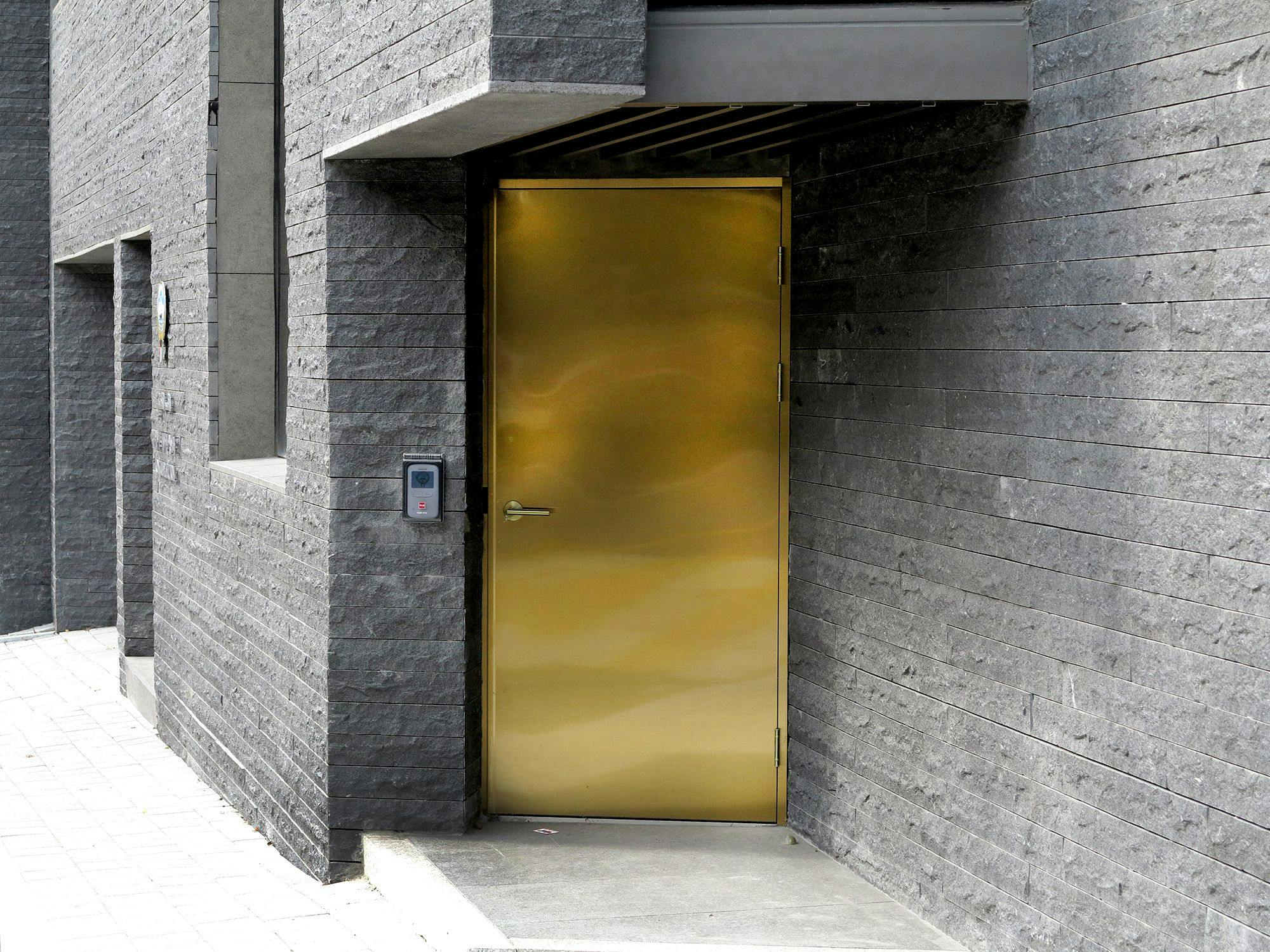Sésame, Ouvre-Toi!
Listen to this text
A wall is a structure erected to separate Space A and Space B.
A portal is a hole created to allow things to pass between Space A and Space B.
A door is a device designed to control the flow of things between Space A and Space B.
A jib is a door that is completely flush with a wall. It is a door that is designed to produce a sense that there is no door, suggesting the necessity for a visually neutral space. Such a door can often be found in galleries and museums displaying contemporary art. The jib is a crucial element in the production of what we conceive as the White Cube.
This is my memory of a painting of a door by Sigmar Polke. I remember seeing it in MoMA in December 2011. For some reason, I can’t find an image of it online. To be honest, I’m really surprised; I cannot imagine what cannot be found online. Consisting of nothing more than a black line and circle on a white background, this painting is immediately recognizable as a door. Depictions of doors often refer to longings for a new path, to the possibility of situations opening (and closing).
Some doors come with locks. In 2002, the artist Dora García locked a room and kept it locked. She said, Unlocking and entering The Locked Room means destroying the work.
Sometimes, the key to unlocking a door can be a word. The most infamous password associated with the opening of a door is Open Sesame. It is a magical phrase lifted from Antoine Galland’s French translation of “Ali Baba and the Forty Thieves,” a short story found in the anthology of stories One Thousand and One Nights. Sésame, ouvre-toi (Sesame, open yourself) has been classified by folklorist Stith Thompson as motif element D1552.2, Mountain opens to magic formula.
A cheat code is a key to a door that unlocks numerous advantages for a gamer. The most famous cheat code is written into Konami games like Contra and Gladius, where inputting Up, Up, Down, Down, Left, Right, Left, Right, B, A on a control pad at the title menu will allow you to gain thirty lives. I’ve only ever completed Contra with thirty ill-gotten lives.
The Key in The Lost Room, a miniseries that screened on Syfy back in 2006, allows anyone to open any hinged door with a pin tumbler lock, transforming that door into a portal to anywhere the user can visualize. I want this cheat.
The ultimate cheat code for doors is to not require a door in the first place. Kitty Pryde, a fictional character in the Marvel Universe, can pass through walls by dematerializing (she remains visible), effectively canceling the need for doors. Among the myriad characters in the Marvel Universe who have absolutely no need for doors are Nightcrawler, The Vision, Doctor Strange, Wong, and The Scarlet Witch. But none of them, I feel, does it with as much style as Kitty.
When is a door not a door? When it’s ajar. There’s nothing worse than false hope.
A Hellmouth is a door to hell. It is often visualized as the massive open mouth of a large monster. This gaping mouth allows passage to the netherworld. In some depictions it is guarded by an unnamed archangel; in others, by Lucifer himself. In Chinese mythology, the door to hell is guarded by 牛头马面, literally Ox Head and Horse Face, which represent the first supernatural beings one encounters after death.
No Exit is a play by Jean-Paul Sartre. A cornerstone of existentialist philosophy, it gave birth to the phrase “Hell is other people.” Even if a door opens and an exit dramatically presents itself, you might not necessarily be ready to leave the hell you’ve dug yourself. No Doors, No Windows is a collection of short stories by Harlan Ellison, published by Pyramid Books in 1975. Ellison is best known for his short story “I Have No Mouth, and I Must Scream,” for which he won the Hugo Award in 1968. It is absolutely one of the cruelest things I’ve ever read, and the worst depiction of hell I’ve ever read. Go read it!
A passport is a key that might open the door to a country. Not all passports are equal. Sometimes, an additional key is required. This device is called a visa. In 2022, a Japanese passport will gain you access to 193 countries without a visa while a passport issued in Afghanistan will allow you to visit a mere twenty-seven countries. The place where one can apply for a visa is an embassy.
Door: Why it's simply impassable!
Alice: Why, don't you mean impossible?
Door: No, I do mean impassable. (chuckles) Nothing's impossible!

5 May 2018, Tokyo. I got off the subway at Azabu-Juban and had a snack at the fancy Family Mart across from Exit 5a, eating my Spam onigiri and sipping from my miniature can of Pepsi with no idea that I was about to chance upon a new project. I had planned to walk a great distance in circles around Hiroo that day and was very excited at that prospect. I turned a corner and found myself in front of an embassy, flanked by another embassy. I quickly realized that this was a neighborhood in Tokyo with clusters of embassies, not unlike Nassim Road in Singapore. I was fascinated with the architecture of the buildings. These things are built like fortresses, but considerable effort goes into making them look friendly and accessible, which they are obviously not. I walked along the borders of the first embassy, touching the walls. They felt solid. A thought hit me: there must be a backdoor to this compound. I followed the wall and saw a tiny path leading to a small domestic looking corridor. A nondescript door lay at the end of it, surrounded by pipes and gas meters. I started imagining all the things that pass through this backdoor. Secret messages. Pizza. Political refugees. I took a photograph and, in that moment, decided to photograph all the backdoors of every embassy I could locate. I prefer to keep my findings a secret, so I would never tell anyone which backdoor belongs to which embassy, nor their corresponding cities. I have since photographed almost every backdoor of every embassy in every city I’ve traveled to. I have decided to name this archive of photographs Foreign Affairs.

Heman Chong is an artist whose work is located at the intersection between image, performance, situations, and writing. Chong’s practice can be read as an imagining, interrogation, and sometimes intervention into infrastructure as an everyday medium of politics. His work has been the subject of solo exhibitions at STPI, Het Nieuwe Instituut, Weserburg Museum, Jameel Arts Center, Swiss Institute, Art in General, Artsonje Center, Rockbund Art Museum, South London Gallery, and NUS Museum, amongst many others. Chong is the co-director and founder (with Renée Staal) of The Library of Unread Books, a library made up of donated books previously unread by their owners.
Instagram
@hemanchong
YouTube
@ambientwalking
Photo by Sung Hwan Kim